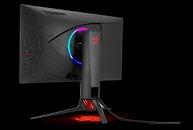Monday, November 27th 2017

ASUS Launches ROG STRIX XG258Q Monitor: 24.5" TN, 1080p, 1ms, 240 Hz FreeSync
ASUS has added yet another monitor to its already long list of display solutions for customers. The ROG STRIX XG258Q monitor, as the "Strix" name implies, has been designed with gamers in mind, and is one of ASUS' eSports-designed offerings, promising unmatched fluidity in fast frame-rate titles with its 240 Hz refresh rate and 1 ms response time. To add even more smoothness to the picture, ASUS has also fitted this Strix monitor with FreeSync support (in the 48 Hz to 240 Hz range), which means there is now another high refresh-rate solution for AMD users.
To achieve this kind of refresh rate speeds, ASUS has made use of a 1080p, TN-based panel, which will deliver better gaming performance at the cost of viewing angles and (usually) color accuracy and contrast when compared to other technologies (contrast is set at 1000:1 and the panel is a 6-bit type with FRC). Added technologies include ASUS' ELMB (Extreme Low Motion Blur), as well as ASUS' Aura RGB lighting effects on the back of the monitor, with an added red ROG logo being projected on to the users' desk from the base of the display. Brightness is being touted at a higher than average 400 nits, but there's no mention of HDR support. Connectivity includes 1x HDMI 1.4 (refresh rates up to 140 Hz), 1x HDMI 2.0, and 1x DisplayPort 1.2. The ASUS ROG Strix XG258Q is available for $449, which is slightly more than $50 cheaper than the current market price of the ROG Swift PG258Q, which substitutes FreeSync for NVIDIA's G-Sync.
Source:
AnandTech
To achieve this kind of refresh rate speeds, ASUS has made use of a 1080p, TN-based panel, which will deliver better gaming performance at the cost of viewing angles and (usually) color accuracy and contrast when compared to other technologies (contrast is set at 1000:1 and the panel is a 6-bit type with FRC). Added technologies include ASUS' ELMB (Extreme Low Motion Blur), as well as ASUS' Aura RGB lighting effects on the back of the monitor, with an added red ROG logo being projected on to the users' desk from the base of the display. Brightness is being touted at a higher than average 400 nits, but there's no mention of HDR support. Connectivity includes 1x HDMI 1.4 (refresh rates up to 140 Hz), 1x HDMI 2.0, and 1x DisplayPort 1.2. The ASUS ROG Strix XG258Q is available for $449, which is slightly more than $50 cheaper than the current market price of the ROG Swift PG258Q, which substitutes FreeSync for NVIDIA's G-Sync.




19 Comments on ASUS Launches ROG STRIX XG258Q Monitor: 24.5" TN, 1080p, 1ms, 240 Hz FreeSync
Yeah I know it's freesync but hey you don't buy a 240Hz monitor to play your games at 60fps!!
Edit: And light placed in a place you never look at is yet another genius move.
The light in the back reflects from the wall, creating effect similar to Ambilight on Philips LCD TV's.
I like ASUS monitors, only downside I can already see is lack of VESA mounts for wall. Why is this such an exotic feature? If you spend so much money on monitor you'd expect it to at least have VESA mount points on it along with other stuff...
p.s. no VESA :fear:
Easiest way to test this is full white cursor moving fast across full black background. Same refresh rate, just different pixels response time. You'll see what I mean.
If the monitor would do 240Hz and all pixels would have a response time of 1ms, then yes, you'd be spot on. Unfortunately for the consumer, that's not how monitors are being built. Many transitions are way slower than the advertised response time, slower than it is required to achieved the advertised refresh rate. That's why we have overdrive, to try and corral all those transitions inside the needed interval. That is what matters and that's why the advertised response times are useless in practice.
For example, look at the actual response times for a 144Hz, 1ms display: www.tftcentral.co.uk/reviews/samsung_c32hg70.htm#response
And here is a 100Hz, 4ms display: www.tftcentral.co.uk/reviews/dell_alienware_aw3418dw.htm#response
1ms GtG is all fine and well, but that is not the entire range that pixel is capable of, industry standard or not.
if the full range would be WtW or BtB that is what should be being used, as well legally they should be "forced" to follow a minimum refresh rate or something like that.
What I mean is taking everything into account input lag, pixel refresh rate etc etc. 1ms GtG is the "average" time for all the pixels to transition, not a will always be that fast or faster, and in this case 240Hz is all well and good, but, does that Hz really matter when there will be a bottleneck happening that your graphics adapter cannot keep the display fed quickly enough or the graphics adapter is seriously capable of out pacing what the display is capable of showing?
Also at least IMO while I like the stand, the extra lighting effects burn power for nothing, and they should have rated the maximum power consumption at full brightness or something bing the 400cd/2 not at 200cd/2 65w is still a fair amount when only at 1/2 brightness going by full specs (to me anyways) I wonder how much of that is being wasted for those extra "look at my gaming monitor" l33t teenager lighting bs lol.